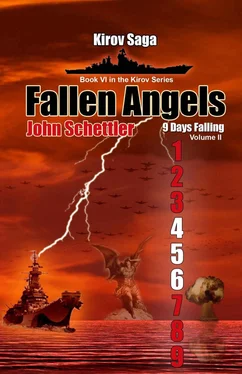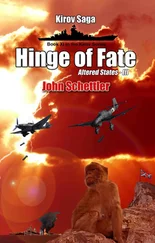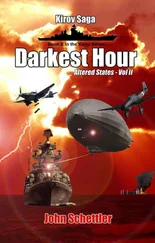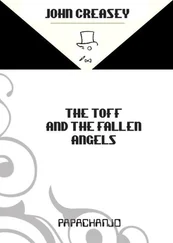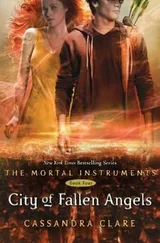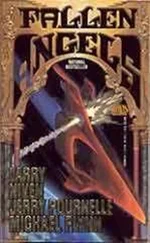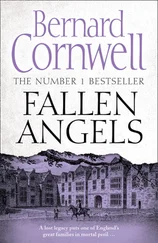Thank God for armor, thought Captain Wellborn. We rolled with the punches, like a fighter on the ropes taking it in the gut. There was nothing wrong with those Big Sticks out front now, he reasoned, looking at the massive turrets. If only I had a target! Then he realized the rockets had betrayed the exact bearing of the firing ship. The long smoky contrails pointed out the way. All he had to do was sight down that axis and he would find his enemy in time, but at what range? The horizon was nearly twenty miles away now, the sun lowering as the time passed through 18:00 hours. Sunset was 20:56, plenty of daylight left in these high latitudes. If they kept coming he should see them soon, silhouetted against the gloaming sky.
Yet Iowa could fire much farther than that horizon. Her guns could lob their massive 2700 pound shells out twenty-four miles. Wellborn was not going to wait for the enemy to come at him again without answering. He ordered his number one turret to fire. They had no firing solution, no target in sight, just a bearing, but the big guns blasted away anyway. Iowa was clearing her throat, and the sheer concussion blew out the last of the flames on her forward deck.
The sound of the massive guns going off set the ship’s crew to cheering, which is exactly what Wellborn wanted. You don’t lay on the ropes and just take it. You throw punches back, whether you can reach the other fellow or not. In a hot minute some 8100 pounds of metal would plow into the ocean out there. They would see those rounds and know we’re still here and ready to fight.
* * *
Theydid see them. Rodenko called a warning and Kirov tracked the incoming shells on radar as if they were missiles. Amazingly, they came arcing up from the distant curve of the earth and then descended, on a perfect line to their present heading and just a couple thousand meters ahead of the Orlan . The blind haymaker Iowa threw back at them had very nearly grazed their chin. Orlan , out in front, was much closer, and they had a good look at the tall water spouts rising as the big shells plummeted into the sea.
“Rodenko—I thought we were jamming their fire control radars.” Karpov’s complaint was an obvious one. The shot had been far closer than it should have been.
“We are, sir. There is no way they can read our position on Radar through the clutter we’re hitting them with.”
In an instant Karpov realized what had happened. “Helm, come left fifteen degrees,” he said quickly. “They’re firing down our missile wakes. We’ll need to assume a new heading after every salvo. Samsonov, set up three more Moskit-IIs . I want the KA-226 to get me optical images on that ship. I want to see what our missiles did to them in that first salvo.”
Rodenko was nervously watching at the Fregat system, which was still receiving data from their AEW helicopter. He saw what looked like a signal cloud or weather front to the south, then realized what it was. “Conn, Radar.” He began reflexively, the years at that station honing his reflexes as he reported. “Large airborne contact cloud bearing 190 degrees and approaching at 400kph.”
“Range?”
“Ka-226 has the leading edge at 200 kilometers. Fregat should have them in about five minutes. From there it will be another twenty minutes or so before they reach our present position.”
The Captain’s eyes shifted back and forth, hand on his chin. They had sixteen P-400s left. The rest of their SAM defense rested with the Klinok medium range system, which could not yet engage. The Orlan was the real bulwark of the fleet air defense. That ship still had 152 lightning fast SAMs ready for action.
“Nikolin, signal Captain Yeltsin to match our new heading and go to air alert one. We’re going to need them soon.”
How many planes were coming, he wondered? The contact cloud as Rodenko described it was very dense, yet widely dispersed. In spite of his preemptive strike against the American carriers, they got a significant strike wave in the air, and anything that gets through our defense umbrella will arrive right in the heat of my action against this battleship.
His plan was simple. They might fire a hundred rounds at me to get just a single hit. That was what Fedorov told him. Our ammunition is limited, but we hit them every time we fire. He had twenty-four more SSMs on Kirov , yet he knew each and every one was going to hit and hurt his enemy. Against a smaller ship they were awesome lances, perfect for blasting the lighter armored cruisers and destroyers to hell. Against the big battleship they were hard punches indeed, but not fatal blows. Look at the punishment we put on the Yamato , and we still could not sink that ship. I can’t waste my valuable missiles on this ship’s heavy armor…
“Samsonov, we can still program the Moskit-IIs for popup maneuver, can we not?”
“Yes, sir. That is a simple toggle selection.”
“Key all three for popup and hold. I suspect our first salvo hit their side armor. We need to be more precise in our targeting.”
A second salvo from Iowa came in again, very wide now that they had turned on the new heading. This time there were nine rounds falling. Karpov smiled, knowing he had been correct. There was nothing wrong with their jamming. The American Captain was simply firing blind. It was all bluster and no skill, just like the Italians; just like Iwabuchi on Kirishima when he was chasing us in the dark.
“Activate forward deck guns,” said Karpov.
“Sir, aye. Guns ready.”
“Begin firing. Sets of 16 rounds. We’ll show them what precision naval gunnery can really do.”
It was time to dance and jab.
* * *
Thefirst shells landed just shy of the bow, surprising everyone on the Iowa’s bridge. They fell in pairs, obviously from typical twin gun mounts, and from the size of the water plumes Wellborn knew they must be no more than 5 inchers.
“Who the hell is shooting at us?” he bawled, thinking one of the destroyers had come on the scene and misidentified his ship as the enemy. But there were no reports of any ships sighted on any quarter. They seemed completely alone on the sea, and the skies above were clear as well. It was as if the shells were dropping from heaven.
“Watchmen, any contacts?”
“Sir, weather deck. My watch is clear—”
“Belay that! Main mast reports ship sighted, bearing 340!”
Wellborn couldn’t see anything, and the next rounds came in with a dull thud and jarring explosion. The ship had been hit by a small caliber round. A twin Bofors mount was ablaze on the port side, and more rounds were falling astride the long raked bow.
“Navigator, range to horizon—quick! Helm. Starboard ten.”
The Captain saw an explosion forward again, right on the number one turret. The smoke cleared and he took heart. They had 500mm of armor there, all of 19.7 inches. The turret shrugged off the small caliber rounds like nothing had happened. There passed a tense moment, with Wellborn half looking over his shoulder as he waited on his navigator.
“Sir I calculate horizon from main mast at 19.5 miles.”
It was not possible, the Captain thought. He could still see nothing on the horizon, but the top of Iowa’s main mast was 150 feet above the water. Add that to the height of any distant contact and you could peg the range to horizon.
“Give it to me in yards, damn it!”
“Sir, aye, sir. Range to horizon…three, four, three, two, zero.”
The Captain was close by the view ports now, binoculars up, and focused intently on the far horizon, then he thought he saw a slight blemish on the clean edge of the sea.
Читать дальше
